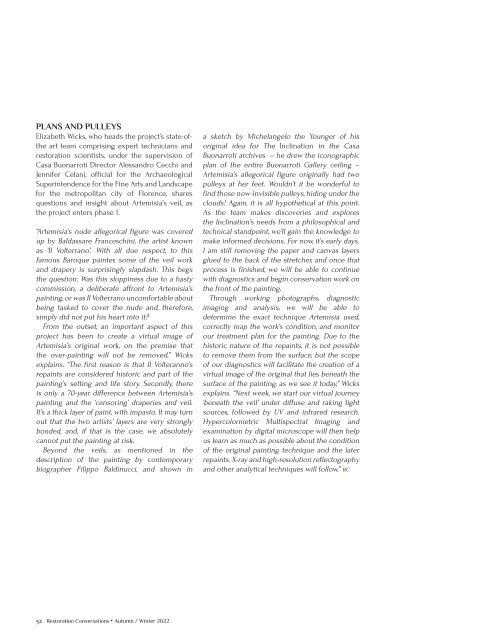Autumn/Winter 2022
Restoration Conversations is a digital magazine spotlighting the achievements of women in history and today. We produce two issues a year: Spring/Summer and Fall/Winter
Restoration Conversations is a digital magazine spotlighting the achievements of women in history and today. We produce two issues a year: Spring/Summer and Fall/Winter
You also want an ePaper? Increase the reach of your titles
YUMPU automatically turns print PDFs into web optimized ePapers that Google loves.
PLANS AND PULLEYS<br />
Elizabeth Wicks, who heads the project’s state-ofthe<br />
art team comprising expert technicians and<br />
restoration scientists, under the supervision of<br />
Casa Buonarroti Director Alessandro Cecchi and<br />
Jennifer Celani, official for the Archaeological<br />
Superintendence for the Fine Arts and Landscape<br />
for the metropolitan city of Florence, shares<br />
questions and insight about Artemisia’s veil, as<br />
the project enters phase 1.<br />
“Artemisia’s nude allegorical figure was covered<br />
up by Baldassare Franceschini, the artist known<br />
as ‘Il Volterrano’. With all due respect, to this<br />
famous Baroque painter, some of the veil work<br />
and drapery is surprisingly slapdash. This begs<br />
the question: Was this sloppiness due to a hasty<br />
commission, a deliberate affront to Artemisia’s<br />
painting, or was Il Volterrano uncomfortable about<br />
being tasked to cover the nude and, therefore,<br />
simply did not put his heart into it?<br />
From the outset, an important aspect of this<br />
project has been to create a virtual image of<br />
Artemisia’s original work, on the premise that<br />
the over-painting will not be removed,” Wicks<br />
explains. “The first reason is that Il Volteranno’s<br />
repaints are considered historic and part of the<br />
painting’s setting and life story. Secondly, there<br />
is only a 70-year difference between Artemisia’s<br />
painting and the ‘censoring’ draperies and veil.<br />
It’s a thick layer of paint, with impasto. It may turn<br />
out that the two artists’ layers are very strongly<br />
bonded, and, if that is the case, we absolutely<br />
cannot put the painting at risk.<br />
Beyond the veils, as mentioned in the<br />
description of the painting by contemporary<br />
biographer Filippo Baldinucci, and shown in<br />
a sketch by Michelangelo the Younger of his<br />
original idea for The Inclination in the Casa<br />
Buonarroti archives – he drew the iconographic<br />
plan of the entire Buonarroti Gallery ceiling –<br />
Artemisia’s allegorical figure originally had two<br />
pulleys at her feet. Wouldn’t it be wonderful to<br />
find those now-invisible pulleys, hiding under the<br />
clouds! Again, it is all hypothetical at this point.<br />
As the team makes discoveries and explores<br />
the Inclination’s needs from a philosophical and<br />
technical standpoint, we’ll gain the knowledge to<br />
make informed decisions. For now, it’s early days.<br />
I am still removing the paper and canvas layers<br />
glued to the back of the stretcher, and once that<br />
process is finished, we will be able to continue<br />
with diagnostics and begin conservation work on<br />
the front of the painting.<br />
Through working photographs, diagnostic<br />
imaging and analysis, we will be able to<br />
determine the exact technique Artemisia used,<br />
correctly map the work’s condition, and monitor<br />
our treatment plan for the painting. Due to the<br />
historic nature of the repaints, it is not possible<br />
to remove them from the surface, but the scope<br />
of our diagnostics will facilitate the creation of a<br />
virtual image of the original that lies beneath the<br />
surface of the painting, as we see it today,” Wicks<br />
explains. “Next week, we start our virtual journey<br />
‘beneath the veil’ under diffuse and raking light<br />
sources, followed by UV and infrared research.<br />
Hypercolormetric Multispectral Imaging and<br />
examination by digital microscope will then help<br />
us learn as much as possible about the condition<br />
of the original painting technique and the later<br />
repaints. X-ray and high-resolution reflectography<br />
and other analytical techniques will follow.” RC<br />
52 Restoration Conversations • <strong>Autumn</strong> / <strong>Winter</strong> <strong>2022</strong>





